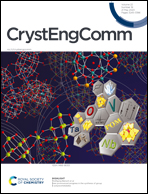A digital workflow from crystallographic structure to single crystal particle attributes for predicting the formulation properties of terbutaline sulfate†
Abstract
A detailed inter-molecular (synthonic) analysis of terbutaline sulfate, an ionic addition salt for inhalation drug formulation, is related to its crystal morphology, and through this to the surface chemistry of the habit faces and surface energy of the whole crystal. Coulombic interactions between the terbutaline cations and sulfate anions contribute 85% of the lattice energy, hydrogen bonding and dispersion interactions contribute 15%. Morphological prediction identifies a plate-like morphology composed of the forms {010}, {100}, {001} and {1![[1 with combining macron]](https://www.rsc.org/images/entities/char_0031_0304.gif) 0} in good agreement with crystals grown from solution. Synthonic modelling of the intermolecular interactions, on a crystal face (hkl)-specific basis, reveals that the surface interactions on the forms with less, relative surface area: {100}, {001} and {1
0} in good agreement with crystals grown from solution. Synthonic modelling of the intermolecular interactions, on a crystal face (hkl)-specific basis, reveals that the surface interactions on the forms with less, relative surface area: {100}, {001} and {1![[1 with combining macron]](https://www.rsc.org/images/entities/char_0031_0304.gif) 0} manifest a greater surface energy, associated, notably, with a greater proportion of polar interactions at these surfaces compared to the morphological dominant {010} surfaces. The predicted total surface energies and their dispersive contributions are found to be in good agreement with those measured at high surface coverage using inverse gas chromatography (IGC). The modelling approach is complementary to IGC, as it enables surface sites of lower energy to be probed, that would require experimentally unachievable surface coverages. The utility of synthonic modelling, in understanding the surface properties of pharmaceutical materials, is highlighted through a workflow-based pathway for digital drug product design encompassing molecule structure, intermolecular packing, crystal morphology, surface energy and formulation properties.
0} manifest a greater surface energy, associated, notably, with a greater proportion of polar interactions at these surfaces compared to the morphological dominant {010} surfaces. The predicted total surface energies and their dispersive contributions are found to be in good agreement with those measured at high surface coverage using inverse gas chromatography (IGC). The modelling approach is complementary to IGC, as it enables surface sites of lower energy to be probed, that would require experimentally unachievable surface coverages. The utility of synthonic modelling, in understanding the surface properties of pharmaceutical materials, is highlighted through a workflow-based pathway for digital drug product design encompassing molecule structure, intermolecular packing, crystal morphology, surface energy and formulation properties.



 Please wait while we load your content...
Please wait while we load your content...